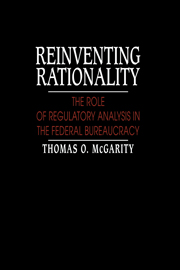Book contents
- Frontmatter
- Contents
- Acknowledgments
- Abbreviations
- Introduction
- Part I The clash of regulatory cultures
- Part II Regulatory analysis in theory and practice
- Part III Structuring regulatory analysis into the decisionmaking process
- Part IV Review of regulatory analysis
- 18 Office of Management and Budget review of regulatory analysis
- 19 Judicial review of regulatory analysis
- Part V Conclusions
- Notes
- Bibliography
- Index
18 - Office of Management and Budget review of regulatory analysis
Published online by Cambridge University Press: 16 October 2009
- Frontmatter
- Contents
- Acknowledgments
- Abbreviations
- Introduction
- Part I The clash of regulatory cultures
- Part II Regulatory analysis in theory and practice
- Part III Structuring regulatory analysis into the decisionmaking process
- Part IV Review of regulatory analysis
- 18 Office of Management and Budget review of regulatory analysis
- 19 Judicial review of regulatory analysis
- Part V Conclusions
- Notes
- Bibliography
- Index
Summary
Rather than leaving regulatory analysis entirely to the agencies, Executive Order 12,291 assigned an important review role to the Office of Management and Budget (OMB). It empowered OMB to designate any minor rule as “major” and to waive regulatory analysis requirements for any major rule. OMB was given authority to identify “duplicative, overlapping and conflicting rules” and rules that were “inconsistent with the policies underlying” the Executive Order and to require “appropriate interagency consultation to minimize or eliminate such duplication, overlap, or conflict.” Finally, the Executive Order required OMB to “[m]onitor agency compliance” with its requirements and to “advise the President with respect to such compliance.” AH regulations and all RIAs accompanying major regulations are reviewed by desk officers in OMB's Office of Information and Regulatory Affairs (OIRA), and most RIAs are also reviewed by a separate group of “superanalysts” in OIRA that set the analytical agendas for all executive agencies. Disputes between OMB and the agencies have been resolved by a vague process that includes the White House. In practice, the vast majority of disputes are resolved in the informal give and take of day-to-day interactions.
The relationship between OMB and most executive agencies cannot fairly be characterized as a cooperative pursuit of common ends. To the contrary, it is typically highly adversarial and often acrimonious. According to a former Deputy Administrator of OIRA: “We yell and scream, jump up and down, do whatever we can to get them to listen to us.” Disputes between OSHA and OMB have been especially bitter.
- Type
- Chapter
- Information
- Reinventing RationalityThe Role of Regulatory Analysis in the Federal Bureaucracy, pp. 271 - 291Publisher: Cambridge University PressPrint publication year: 1991
- 2
- Cited by



